Weapons of the Vietnam War
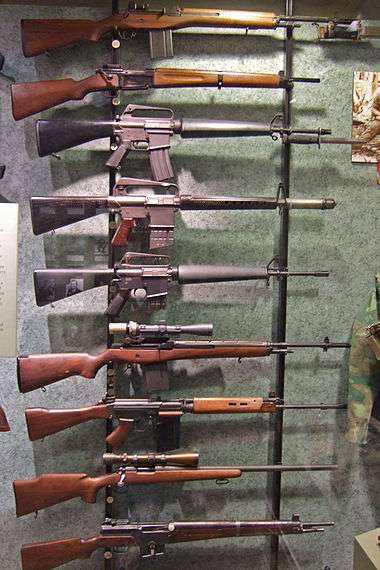
This article is about the weapons used in the Vietnam War, which involved the People’s Army of Vietnam (PAVN) or North Vietnamese Army (NVA), National Liberation Front for South Vietnam (NLF) or Viet Cong (VC), and the armed forces of the Army of the Republic of Vietnam (ARVN), United States, Republic of Korea, Philippines, Thailand, and the Australian, New Zealand defence forces, and a variety of irregular troops.
Nearly all United States-allied forces were armed with U.S. weapons, some of which, such as the M1 Carbine, were substitute standard weapons dating from World War II. The Australian army employed the 7.62 mm L1A1 Self-Loading Rifle as their service rifle, with the occasional US M16.
The NVA, although having inherited a variety of American, French, and Japanese weapons from World War II and the First Indochina War (aka French Indochina War), were largely armed and supplied by the People's Republic of China, the Soviet Union, and its Warsaw Pact allies. In addition, some weapons—notably anti-personnel explosives, the K-50M (a PPSh-41 copy), and “home-made” versions of the RPG-2—were manufactured in Vietnam. By 1969 the US Army had identified 40 rifle/carbine types, 22 machine gun types, 17 types of mortar, 20 recoilless rifle or rocket launcher types, 9 types of antitank weapons, and 14 anti-aircraft artillery weapons used by ground troops on all sides. Also in use, primarily by anti-communist forces, were the 24 types of armored vehicles and self-propelled artillery, and 26 types of field artillery & rocket launchers.
Communist forces and weapons
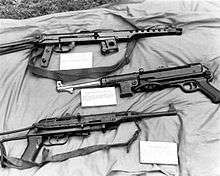
Communist forces were principally armed with Chinese and Soviet weaponry though some Viet Cong guerrilla units were equipped with Western infantry weapons either captured from French stocks during the first Indochina war, such as the MAT-49, or from ARVN units or requisitioned through illicit purchase.
US weapons
The American M16 rifle, which replaced the M14, was lighter and considered more accurate than the AK-47 but was prone to jamming. Often the gun suffered from a jamming flaw known as "failure to extract," which meant that a spent cartridge case remained lodged in the chamber after a bullet flew out the muzzle. According to a congressional report, the jamming was caused primarily by a change in gunpowder which was done without adequate testing and reflected a decision for which the safety of soldiers was a secondary consideration.
The heavily armored, 90 mm M48A3 Patton tank saw extensive action during the Vietnam War and over 600 were deployed with US Forces. They played an important role in infantry support though there were few tank versus tank battles. The M67A1 flamethrower tank (nicknamed the Zippo) was an M48 variant used in Vietnam. Artillery was used extensively by both sides but the Americans were able to ferry the lightweight 105 mm M102 howitzer by helicopter to remote locations on quick notice.[1][2] With its 17-mile (27 km) range, the Soviet 130 mm M-46 towed field gun was a highly regarded weapon and used to good effect by the NVA. It was countered by the long-range, American 175 mm M107 Self-Propelled Gun.[3]
The United States had air superiority though many aircraft were lost to surface-to-air missiles and anti-aircraft artillery. U.S. air power was credited with breaking the siege of Khe Sanh and blunting the 1972 Communist offensive against South Vietnam. At sea, the U.S. Navy had the run of the coastline, using aircraft carriers as platforms for offshore strikes and other naval vessels for offshore artillery support. Offshore naval fire played a pivotal role in the Battle for the city of Hue, providing accurate fire in support of the U.S. counter-offensive to retake the city.[4]
The Vietnam War was the first conflict that saw wide scale tactical deployment of helicopters.[5] The Bell UH-1 Iroquois was used extensively in counter-guerilla operations both as a troop carrier and a gunship.[2] In the latter role, the "Huey" as it became affectionately known, was outfitted with a variety of armaments including M60 machine guns, multi-barreled 7.62 mm Gatling guns and unguided air-to-surface rockets.[2] The Hueys were also successfully used in MEDEVAC and search and rescue roles.[2]
Weapons of the ARVN, US, South Korean, Australian, and New Zealand Forces
Pistols and revolvers
- Colt M1911A1 – Standard US Military sidearm.
- Browning High Power – used by Australian and New Zealand forces. Also used on an unofficial basis by US Reconnaissance and Special Forces units.
- Smith & Wesson Mark 22 Mod.0 "Hush Puppy" – Suppressed pistol used by SEALs and other United States special operations forces.[6]
- Colt Model 1903 Pocket Hammerless – Carried by US Military Officers. Replaced by the Colt Commander in the mid-1960s
- Colt Commander – Replaced the Colt M1903 as an Officer's sidearm in the mid-1960s.
- M1917 revolver – Used by the South Vietnamese and US forces during the beginning of the war alongside the Smith & Wesson Model 10. Used rather prominently by 'Tunnel Rat' units.
- Smith & Wesson Model 10 – Used concurrently with Colt and S&W M1917 Revolvers.
- Smith & Wesson Model 12 – Carried by US Army and USAF pilots.
- Smith & Wesson Model 15 – Carried by USAF Security Police Units
- Smith & Wesson Model 27 – Carried by MACV-SOG
- High Standard HDM – Integrally suppressed .22LR handgun, supplemented by the Mark 22 Mod 0 in the later stages of the war.[6]
Infantry rifles

- L1A1 Self-Loading Rifle – Used by Australian and New Zealand soldiers in Vietnam
- AR-10 – Limited Uses

- M1 Garand – Used by the South Vietnamese, South Koreans and Laotians. Limited numbers were carried by early US advisors and USMC troops.
- M1, M1A1, & M2 Carbine – Used by the South Vietnamese Military, Police and Security Forces, US Military, and Laotians supplied by the United States.
- M1903A3 Springfield – Limited numbers were used by the South Vietnamese and USMC.
- M14 rifle Issued to most troops from the early stages of the war until 1967-68, when it was replaced by the M16.[7]
- M16, XM16E1, and M16A1 – The M16 was issued in 1963, but due to reliability issues, it was replaced by the M16A1 in 1967 which added the forward assist and chrome-lined barrel to the rifle for increased reliability.[8]
- CAR-15 – Carbine variant of the M16 produced in very limited numbers, fielded by special operations early on. Later supplemented by the improved XM177.
- XM177 (Colt Commando) – Further development of the CAR-15, used heavily by MACV-SOG, the US Air Force, and US Army.[6]
- Stoner 63 – used by U.S. Navy SEALs and USMC.[6]
- Heckler & Koch G3 – Used by Thai forces.
- Heckler & Koch HK33 – Used by Thai forces that were not armed by the United States. It was chambered for the same cartridge as the M16 assault rifle used by American troops.
- T223 – which is a copy of the Heckler & Koch HK33 Assault Rifle under license by Harrington & Richardson used in small numbers by Navy SEAL teams. Even though the empty H&R T223 was 0.9 pounds (0.41 kg) heavier than an empty M16A1, the weapon had a forty-round magazine available for it and this made it attractive to the SEALS.[6]
Sniper/Marksman Rifles
- M1917 Enfield – Limited numbers were used by the South Vietnamese.
- Lee-Enfield – Used by ANZAC Forces.
- M1C/D Garand – Limited numbers were used by the South Vietnamese.
- M1903A4 Springfield – Used by the USMC throughout the war, replaced by the M40.
- M21 Sniper Weapon System – Designated Marksman Rifle (DMR) used by the US Army.
- M40 – Bolt-action sniper rifle meant to replace the M1903 Springfield rifle; used by the US Marines.
Submachine guns
- Thompson submachine gun – Used often by South Vietnamese troops, and in small quantities by US artillery and helicopter units.
- M3 Grease gun – Standard US Military submachine-gun, also used by the South Vietnamese[6]
- Ingram MAC-10 – Used by US special operations forces.[6]
- Swedish K – Used by Navy SEALs in the beginning of the war, but later replaced by the Smith & Wesson M76 in the late 1960s. Significant numbers were also utilized by the South Vietnamese,[6] and limited numbers were used in Laos by advisors, and Laotian fighters.
- Smith & Wesson M76 – A copy of the Swedish K, replacing it in 1967.[6]
- Madsen M-50 – Large numbers utilized by South Vietnamese and US forces, supplied from Denmark.[6]
- Owen Gun – Standard Australian submachine-gun in the early stages of the war, later replaced by the F1.
- F1 submachine gun – Replaced the Owen Gun in Australian service.
- Sterling submachine gun – Used by Australian SASR and other special operations units.
- Sten submachine gun – Used by US special operations forces, often with a suppressor mounted.
- Uzi – Used by special operations forces, supplied from Israel.
- Beretta M12 – Limited numbers were used by US embassy security units.[9]
- MAT-49 submachine gun – captured models were used in limited numbers [6]
- MP40 – Limited numbers were used by MACV-SOG and other irregular forces.[6]
Shotguns

The shotguns were used as an individual weapon during jungle patrol; infantry units were authorized a shotgun by TO & E (Table of Organization & Equipment). Shotguns were not general issue to all infantrymen, but were select issue, such as one per squad, etc.
- Winchester Model 1912 pump-action shotgun was used by the Marines during the early stages of the war.
- Ithaca 37 pump-action shotgun Used by NAVY SEALS.[6]
- Remington 7188 experimental select fire shotgun. Withdrawn due to lack of reliability.[6]
- Remington Model 870 pump-action shotgun primary shotgun used by Marines after 1966[6]
- Special Operations Weapon a modification for a Remington 1100 which made it fully automatic
- Remington 11-48 semi-automatic shotgun used by the Marines in small quantities
- Winchester Model 1897 used by the Marines during the early stages of the war, but was later replaced by the Remington Model 870
- Winchester Model 1200 Pump-action shotgun used by the US Army
- Stevens Model 520-30 and Model 620[10]
- Stevens Model 77E, pump-action shotgun used by Army and Marine forces in Southeast Asia. Almost 70,000 Model 77Es were procured by the military for use in SE Asia during the 1960s
Machine guns
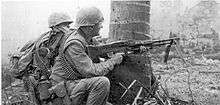
- L2A1 AR – Full-automatic capable version of the L1A1 SLR used by ANZAC forces
- Stoner M63a Commando & Mark 23 Mod.0 – used by U.S. Navy SEALs and tested by Force Recon [6]
- M60 machine gun GPMG (General Purpose Machine Gun) Standard General Purpose Machine Gun for the US, Australian, New Zealand, and South Vietnamese forces.[6]
- M1918A2 – Browning Automatic Rifle Issued to troops during the early stages of the war by the United States. But Many were airdropped into Laos and used by Laotian fighters. Also used by South Vietnamese.
- M1917 Browning machine gun – A .30cal heavy machine gun issued to some machine gunners in the South Vietnamese Army and also in limited use by the US Army.
- M1919 Browning machine gun – Vehicle and helicopter mounted machine gun. Also fitted to Australian M113 Light Reconnaissance Vehicles.[6] Meanwhile, still of use by many South Vietnamese and Laotion infantry forces.
- Heckler & Koch HK21 – Used by Thai forces.
- Colt CMG-2 Experimental light machine gun deployed by SEAL Team 2 in 1970.[6]
- Browning M2HB .50cal Heavy Machine Gun [6]
Grenades and mines
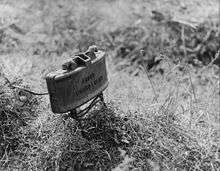
- Mark 2 Fragmentation Hand/Rifle Grenade
- M61 Fragmentation Hand Grenade
- M34 white phosphorus grenade is a smoke grenade that uses white phosphorus, which, when in contact with air ignites and creates white smoke. The white phosphorus was also a useful way to dislodge the Viet Cong from tunnels or other enclosed spaces as the burning white phosphorus absorbs oxygen, causing the victims to suffocate or suffer serious burns.
- M18 grenade Smoke Hand Grenade
- Claymore M18A1 – An anti-personnel mine
- M67 grenade
- M16 mine – A bounding anti-personnel mine
Grenade launchers
M79 Grenade Launcher The Primary US grenade launcher of the Vietnam war. it was used by all branches of the US military.[6]
The China Lake Grenade Launcher, a pump action weapon, also saw action in the Vietnam War albeit in very small numbers.[6]
XM148 Experimental underbarreled 40mm grenade launcher. Used by Navy SEALs and Australian SAS. Withdrawn due to safety reasons.[6]
M203 grenade launcher, The M203 is a single-shot 40mm underslung grenade launcher designed to attach to a M16 rifle. First tested in combat April 1969.[6]
M7 grenade launcher, The M7 is a rifle grenade launcher used with the M1 Garand. Used by the South Vietnamese solders.
Flamethrowers

Infantry support weapons
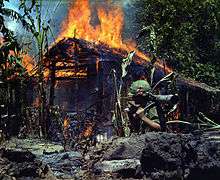
- M18 recoilless rifle 57 mm,
- M20 recoilless rifle 75 mm
- M67 recoilless rifle Anti-Tank 90 mm
- M40 recoilless rifle 106 mm
- M19 Mortar 60 mm
- M29 Mortar 81 mm
- 4.2 inch mortar 107 mm commonly referred to as the "four deuce"
- M72 LAW Light Anti-Tank Weapon
- M31 HEAT Rifle Grenade Used primarily by the U.S. Army before the introduction of the M72 LAW. Fired from the M1 Garand and M14 Rifle.
- M20 Super Bazooka Used mainly by U.S. Marine Corps before the introduction of the M72 LAW
- FIM-43 Redeye MANPADS (Man-Portable Air-Defence System) Shoulder-fired heat-seeking anti-air missile, used by the US Army and US Marines.
Artillery

- 105 mm Howitzer M2A1
- 105 mm Howitzer M102
- 155 mm Howitzer M114
- M53 Self-propelled 155mm gun
- M55 Self-propelled 8-inch howitzer
- M107 Self-propelled 175mm gun
- M108 Self-propelled 105 mm howitzer
- M109 Self-propelled 155 mm howitzer
- M110 Self-propelled 8-inch howitzer
- 75mm Pack Howitzer M1
- L5 pack howitzer 105 mm pack howitzer used by Australia
Artillery ammunition types
- Beehive anti-personnel rounds
- White phosphorus (marking round) "Willie Pete"
- HE, general-purpose (High Explosive)
- Canister
Aircraft
(listed alphabetically by modified/basic mission code, then numerically in ascending order by design number/series letter)
- A-1 Skyraider ground attack aircraft
- A-3 Skywarrior carrier based bomber
- A-4 Skyhawk carrier borne strike aircraft
- A-6 Intruder carrier borne all weather strike aircraft
- A-7 Corsair II carrier borne strike aircraft
- A-26 Invader light bomber
- A-37 Dragonfly ground attack aircraft
- AC-47 Spooky gunship
- AC-119G "Shadow" gunship
- AC-119K "Stinger" gunship
- AC-130 "Spectre" gunship
- B-52 Stratofortress heavy bomber
- B-57 Canberra medium bomberForce
- B-66 Destroyer medium bomber
- Canberra B.20 Royal Australian Air Force medium bomber
- C-1 Trader cargo/transport aircraft
- C-2 Greyhound cargo/transport aircraft
- C-5 Galaxy strategic lift cargo aircraft
- C-7 Caribou tactical cargo aircraft – used by the U.S. Air Force and the Royal Australian Air Force
- C-47 cargo/transport aircraft
- C-97 Stratofreighter cargo/transport aircraft
- C-119 Boxcar cargo/transport aircraft
- C-123 Provider cargo/transport aircraft
- C-124 Globemaster II cargo/transport aircraft
- C-130 Hercules cargo/transport plane
- C-133 Cargomaster cargo/transport aircraft
- C-141 Starlifter strategic cargo aircraft
- E-1 Tracer carrier-based airborne early warning (AEW) aircraft
- E-2 Hawkeye carrier-based airborne early warning (AEW) aircraft
- EA-3 Skywarrior carrier-based tactical electronic reconnaissance aircraft
- EA-6B Prowler carrier-based electronic warfare & attack aircraft
- EB-57 Canberra tactical electronic reconnaissance aircraft
- EB-66 tactical electronic reconnaissance aircraft
- EC-121 reconnaissance aircraft
- EF-10 Skyknight tactical electronic warfare aircraft
- EKA-3B Skywarrior carrier-based tactical electronic warfare aircraft
- F-4 Phantom II carrier and land based fighter-bomber
- F-5 Freedom Fighter light-weight fighter used in strike aircraft role
- F-8 Crusader carrier and land based fighter-bomber
- F-9 Cougar fighter
- F-86 Sabre fighter jet used by the Royal Australian Air Force
- F-100 Super Sabre fighter-bomber
- F-102 Delta Dagger fighter
- F-104 Starfighter fighter
- F-105 Thunderchief fighter-bomber
- F-111 Aardvark medium bomber
- HU-16 Albatross rescue amphibian
- KA-3 Skywarrior carrier-based tactical aerial refueler aircraft
- KA-6 Intruder carrier-based tactical aerial refueler aircraft
- KB-50 Superfortress aerial refueling aircraft
- KC-130F Hercules tactical aerial refueler/assault transport aircraft
- KC-135 Stratotanker aerial refueling aircraft
- O-1 Bird Dog, light observation airplane
- O-2 Skymaster, observation aircraft
- OV-1 Mohawk battlefield surveillance and light strike aircraft
- OV-10 Bronco, light attack/observation aircraft
- P-2 Neptune maritime patrol aircraft
- P-3 Orion maritime patrol aircraft
- QU-22 Pave Eagle (Beech Bonanza) electronic monitoring signal relay aircraft
- RA-3B Skywarrior carrier-based tactical photographic reconnaissance aircraft
- RA-5C Vigilante carrier-based tactical photographic reconnaissance aircraft
- RB-57 Canberra tactical photographic reconnaissance aircraft
- RB-66 tactical photographic reconnaissance aircraft
- RF-4 Phantom II carrier and land-based tactical photographic reconnaissance aircraft
- RF-8 Crusader carrier-based tactical photographic reconnaissance aircraft
- RF-101 Voodoo tactical photographic reconnaissance aircraft
- S-2 Tracker carrier-based anti-submarine warfare (ASW) aircraft
- SR-71 Blackbird strategic reconnaissance aircraft
- T-28 Trojan trainer, used as ground attack aircraft
- U-2 reconnaissance aircraft
- U-6 Beaver utility aircraft
- U-10 Helio Courier utility aircraft
_at_anchor_in_the_Mekong_Delta_ca_late_1960s.jpg)
Helicopters
(listed numerically in ascending order by design number/series letter, then alphabetically by mission code)
- UH-1A/B/C/D/E/F/H/L/M/P Iroquois "Huey", utility transport and gunship helicopter
- AH-1G HueyCobra attack helicopter
- AH-1J SeaCobra twin-engine attack helicopter
- HH-1K Iroquois search and rescue (SAR) helicopter
- UH-1N Iroquois twin-engine utility helicopter
- SH-2 Seasprite carrier-based anti-submarine warfare (ASW) helicopter
- UH-2 Seasprite carrier-based utility helicopter
- CH-3 Sea King long-range transport helicopter
- HH-3 "Jolly Green Giant" long-range combat search and rescue (CSAR) helicopter
- SH-3 Sea King carrier-based anti-submarine warfare (ASW) helicopter
- UH-3 Sea King carrier-based utility helicopter
- OH-6A Cayuse "Loach" (from LOH - Light Observation Helicopter), light transport/observation (i.e., scout) helicopter
- OH-13 Sioux light observation helicopter
- UH-19 Chickasaw utility transport helicopter
- CH-21 Shawnee cargo/transport helicopter
- OH-23 Raven light utility helicopter
- CH-34 Choctaw cargo/transport helicopter
- CH-37 Mojave cargo/transport helicopter
- HH-43 Huskie firefighting/rescue helicopter
- CH-46 Sea Knight cargo/transport helicopter
- CH-47 Chinook cargo/transport helicopter
- CH-53 Sea Stallion heavy-lift transport helicopter
- HH-53 "Super Jolly Green Giant" long-range combat search and rescue (CSAR) helicopter
- MH-53 Pave Low special operations missions helicopter.
- CH-54 Tarhe "Sky Crane", heavy lift helicopter
- OH-58A Kiowa light transport/observation (i.e., scout) helicopter
Aircraft ordnance
- GBUs
- CBUs
- BLU-82 Daisy cutter
- Napalm
- Bomb, 250 lb, 500 lb, 750 lb, 1000 lb, HE (high explosive), general-purpose
- Rocket, aerial, HE (High Explosive), 2.75 inch
Aircraft weapons

- M61 Vulcan, 20 mm (aircraft mount)
- M39 cannon, 20 mm (aircraft mount)
- AN/M3 cannon 20 mm (aircraft mount)
- Minigun, 7.62 mm (aircraft and helicopter mount)
- M197 Gatling gun, 20 mm
- M60 machine gun, 7.62mm (helicopter mount)
- AIM-4 Falcon
- AIM-7 Sparrow
- AIM-9 Sidewinder
- AGM-12 Bullpup
- AGM-62 Walleye
- AGM-45 Shrike
- AGM-78 Standard ARM
Chemical Weapons
- Agent Orange- While not developed to be used as a weapon against infantry, it was later revealed that it had the potential to cause cancer and other diseases in those who came in contact with it.
- Napalm
Vehicles
- M38A1 1/4 ton jeep
- M151 1/4 ton jeep
- Dodge M37, 3/4 ton truck
- Kaiser-Jeep M715 1¼ ton truck
- Truck, cargo/troops, 2½ ton (deuce and a half)
- Truck, cargo/troops, 5 ton
- M520 Goer Truck, Cargo, 8-ton, 4×4
- Land Rover short and long wheelbase – Australian and New Zealand forces.
- M135 troop/Cargo trucks, 2 1/2 ton
- M211 Cargo/troop truck, 2 1/2 ton
Combat vehicles
Tanks
- M24 Chaffee Light tank – Main ARVN tank early in the war, used at least as late as the Tet Offensive.
- M41 Walker Bulldog Light tank – Replaced the M24 Chaffee as the main ARVN tank in 1964-1965.
- M48 Patton medium tank – Main tank of the US Army and Marines throughout the war, and also used by ARVN forces late-war.
- M103 Heavy Tank – Heavy tank used by the US Army and USMC. Deployed in Vietnam but never actually saw combat.
- M67 "Zippo" – Flamethrower variant of the M48 Patton.
- M551 Sheridan Armored Reconnaissance Airborne Assault Vehicle/Light Tank – Used by the US Army from 1969.
- Centurion MK.V Main Battle Tank – Used by the Australian Army.
Other armored vehicles
- M113 APC (Armored Personnel Carrier)
- M113 ACAV Armored Cavalry Assault Vehicle
- M163 Vulcan Is a self-propelled anti-aircraft tank
- M3 Half-track Used by South Vietnamese forces early in the war.
- M728 Combat Engineer Vehicle Modified M60 Patton tank equipped with dozer blade, short-barreled 165mm M135 Demolition Gun, and A-Frame crane.
- M60 AVLB Armored Vehicle Launched Bridge. M60 Patton chassis.
- M88 Recovery Vehicle Armored Recovery Vehicle. M48 and M60 chassis based.
- M8 Greyhound Used by ARVN forces early in the war.
- LVTP5 (aka AMTRACs) Amphibious tractors / landing craft used by US Marine Corps
- M50 Ontos Self-propelled 106 mm recoilless rifle carrier used by the USMC until 1969. Some were later transferred to ARVN forces.
- Cadillac Gage V-100 Commando
- Mark I PBRs (Patrol Boat River)
- LARC-LX
- BARC
- M114 Reconnaissance vehicle
- M42 Duster (M41 light tank based hull, with a twin 40 mm antiaircraft gun mounted on an open turret)
- LCVP Landing craft vehicle personal
- LCM Landing craft mecanised
- M56 Scorpion
Gun trucks
Often, non-combat logistical vehicles were armored and adopted to carry several machine guns to be used for convoy escort duties
- Gun trucks, 2½ and 5 ton cargo trucks with quad .50 cal machine guns mounted in the back
- M3 halftracks with quad .50 cal machine guns in the back
- M151A1C with M40 recoilless rifle 106 mm.
- Jeeps with mounted M60 machine guns
- Land Rovers with single and twin M60 machine guns mounted used by Australian and NZ forces
Naval craft
_slow.jpg)
- Tango, LCM Monitor, heavily gunned riverine craft
- Swift Boat, (PCF) Patrol Craft Fast
- ASPB, Assault Support Patrol Boat, (known as Alpha boats)
- PBR (Patrol Boat River) – All-fiberglass boats propelled by twin water jets, used by the US Navy
- USS George Clymer (APA-27). Troop transport.
Communications

Radios
The geographically dispersed nature of the war challenged existing military communications. From 1965 to the final redeployment of tactical units, numerous communications-electronics systems were introduced in Vietnam to upgrade the quality and quantity of tactical communications and replace obsolete gear:[11]
- The AN/PRT-4 and PRR-9 squad radios replaced the AN/PRC-6.
- The AN/PRC-25 and 77 short-range FM radios replaced the AN/PRC-8-10.
- The AN/VRC-12 series FM radios replaced the RT-66-67-68/GRC (including AN/GRC 3-8, VRC 7-10, VRC 20-22, and VRQ 1-3 sets).
- The AN/GRC-106 AM radios and teletypewriter replaced the AN/GRC-19.
Encryption systems
Encryption systems developed by the National Security Agency and used in Vietnam included:[12]
- The NESTOR tactical secure voice system, including the TSEC/KY-8, 28 and 38 was used with the PRC-77 and VRC-12
- The KW-26 protected higher level teletype traffic
- The KW-37 protected the U.S. Navy fleet broadcast
- The KL-7 provided offline security
- A number of paper encryption and authentication products, including one time pads and the KAL-55B Tactical Authentication System
Weapons of the PAVN/NLF
NVA (North Vietnamese Army) and the Southern communist guerrillas NLF, or Viet Cong as they were commonly referred to during the war, largely used standard Warsaw Pact weapons. Weapons used by the North Vietnamese also included Chinese Communist variants, which were referred to as CHICOM's by the US military.
Artillery
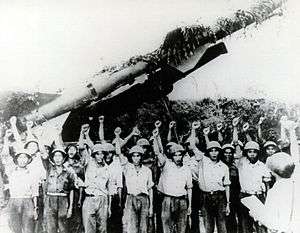
- SA-2 Soviet high-altitude air defence system
- ZPU-4 quad 14.5 mm anti-aircraft machine gun
- ZU-23 twin 23 mm anti-aircraft cannon
- M1939 37 mm anti-aircraft gun
- S-60 57 mm anti-aircraft gun
- 85 mm air defense gun M1939 (52-K)
- 100 mm air defense gun KS-19

- 82 mm, 107 mm, 120 mm, and 160mm mortars
- 122 mm Katyusha rockets
- Type 63 multiple rocket launcher
- BM-8/BM-13/BM-31
- BM-21 Grad
- BM-25 (MRL) limited numbers
- 122 mm gun M1931/37 (A-19)
- 122 mm howitzer M1938 (M-30)
- D-74 122 mm Field Gun
- 130 mm towed field gun M1954 (M-46)
- 152 mm howitzer M1943 (D-1)
- 152 mm towed gun-howitzer M1955 (D-20)
Aircraft
- MiG-21 jet fighter
- MiG-19 jet fighter, used in limited numbers
- MiG-17 jet fighter
- MiG-15 jet fighter, used in limited numbers
- Shenyang J-6 jet fighter
- Shenyang J-5 jet fighter
- An-2 aircraft
- Mi-4 helicopter
- Mi-1 helicopter
- Mi-2 helicopter
- Mi-8 helicopter
Aircraft weapons
Small arms
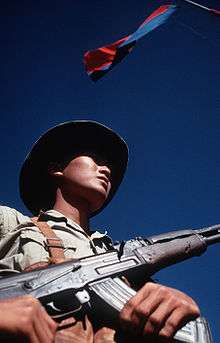

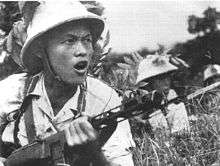

Handguns
- Tokarev TT-33[13]
- Makarov PM[13]
- P-64 CZAK handgun
- Nagant M1895 revolver
- Type 14 8 mm Nambu Pistol – (Captured from the Japanese during World War II)
- Stechkin automatic pistol
- Walther P38 – (captured by the Soviets during World War II and provided to the VPA and the NLF as military aid)
- Luger P08 – (captured by the Soviets during World War II and provided to the VPA and the NLF as military aid)
- Mauser C96 – (locally produced copies were used alongside Chinese copies and German variants supplied by the Soviets.)
Automatic and semi-automatic rifles
- AK-47 and AKM – (from the Soviet Union and Warsaw Pact countries)
- Type 56 assault rifle – (from the People's Republic of China)
- Type 58 assault rifle – (from North Korea)
- Vz. 58 assault rifle – (from Czechoslovakia)
- Type 63 assault rifle
- Sturmgewehr 44 assault rifle – (captured by the Soviets during World War II and provided to the VPA and the NLF as military aid)
- SVD-63 semi-automatic marksman rifle
- Gewehr 43 semi-automatic rifle – (captured by the Soviets during World War II and provided to the VPA and the NLF as military aid)
- M1 Carbine semi-automatic rifle – Captured during the first Indochina War
- MAS-49 rifle – Captured French rifle from first Indochina War
- SKS semi-automatic carbine.
- SVT-40 semi-automatic rifle.
Bolt-action rifles
- MAS-36 rifle Captured French rifle from first Indochina War, used by NVA in earlier stages of the Vietnam War
- Mosin–Nagant bolt-action rifles and carbines (from the Soviet Union, Warsaw Pact countries, and the People's Republic of China)
- Mauser Kar98k bolt-action rifle (many of the Mausers used by the VPA and the NLF were from rifles captured from the French during the First Indochina War and rifles provided to them by the Soviets as military aid)
- Type 38 Rifle – (captured from the Japanese during World War II)
- Type 99 Rifle – (captured from the Japanese during World War II)
Submachine guns
- K-50M submachine gun (Vietnamese edition, based on Chinese version of Russian PPSh-41, under licence)
- PPS-43 submachine gun
- PPSh-41 submachine gun (both Soviet and Chinese versions)
- PPD-34/38 submachine gun
- PPD-40 submachine gun
- MP-38/MP-40 – (captured by the Soviets during World War II)
- Škorpion vz. 61 submachine gun
- MAT-49 submachine gun – Captured during the French-Indochina War. Many were converted from 9x19mm to 7.62x25 Tokarev[6]
- PM-63 submachine gun
- Type 100 submachine gun – Captured in very limited amounts from the Japanese during World War II.
- Thompson submachine gun – Locally produced versions
Machine Guns
- Type 99 LMG
- RPD light machine gun
- RPK light machine gun
- PK light machine gun
- Degtyarev DP light machine gun
- SG-43/SGM medium machine guns (including Communist Chinese copies of these guns)
- MG-34 light machine gun (captured by the Soviets during World War II and provided to the VPA and the NLF as military aid)
- MG-42 medium machine gun (captured by the Soviets during World War II and provided to the VPA and the NLF as military aid)
- Uk vz. 59 general-purpose machine gun
- ZB-53 machine gun from (Czechoslovakia)
- DShK heavy machine gun
- PM M1910 heavy machine gun
Grenades and other explosives
- F1 grenade
- Type 67 ChiCom Stick Grenade
- RG-42 grenade
- RGD-5 grenade
- 9K32 Strela-2 anti-aircraft weapon
- RPG-2 anti-tank weapon (both Soviet and locally produced B-40 and B-50 variants used)
- RPG-7 anti-tank weapon
- Type 69 RPG anti-tank weapon
- SPG-9 73 mm recoilless rifle
- B-10 recoilless rifle
- B-11 recoilless rifle
Flamethrowers
- LPO-50 Flamethrower (limited use)
Tanks
- T-54/55 main battle tanks
- T-34-85 medium tank, used in limited numbers
- Type 59 main battle tanks
- Type 62 light tank
- Type 63 amphibious tank
- PT-76 amphibious tank
- Type 63 anti-aircraft self-propelled systems
- ZSU-57-2 anti-aircraft self-propelled systems
- ZSU-23-4 anti-aircraft self-propelled systems
- IS-2/3/10 Heavy tank supplied by the USSR and was used in limited numbers by the NVA. Used up to the early 1960s.
- SU-100 self-propelled guns in limited numbers.
Other armored vehicles
Vehicles
Substitute standard weapons used by irregular forces
Small arms
- Arisaka bolt-action rifles
- M1 Garand rifle, semi-automatic rifle
- M1 carbine, semi-automatic rifle
- Springfield M1903 bolt-action rifles
- MAS-36 bolt-action rifles
- MAS-49 semi-automatic rifles
- MAT-49 submachine gun and local variants
- MP 40 submachine gun
- PPSh-41 submachine gun
- PPS-43 submachine gun and local variants
- Swedish K submachine guns
- Mosin–Nagant bolt-action rifles and carbines
- Mauser Karabiner 98k bolt-action rifles
- Type 99 light machine gun Used occasionally by the Viet Cong
- Nambu semi-automatic pistol
- Colt M1911A1 Semi-Automatic Pistol
- M72 LAW
Hand combat weapons

- M1 Bayonet U.S. and ARVN Used on M1 Garand.
- M4 bayonet U.S. and ARVN Used on M1, M2 Carbine.
- M5 bayonet U.S. and ARVN Used on M1 Garand.
- M6 bayonet U.S. Used on M14.
- M7 Bayonet U.S. and ARVN with the M16
- Ka-Bar Utility/fighting Knife U.S. Navy & Marine Corps
- Gerber Mark II U.S. Armed Forces
- Other types of knives, bayonets, and blades
Area denial weapons
A wide variety of anti-personnel ordnance and booby traps were used in the Vietnam war, including punji stakes.
- M14 Mine Used by US Forces until 1973
- MBV-78A1 Vietnamese variant of Russian POMZ AP mine
- Type 58 & Type 59 Chinese copy of Russian POMZ-2 and POMZ-2M AP mines
- OZM series of Russian bounding mines
Other ways of obtaining weapons
The Viet Cong were not always able to be supplied by the NVA. They sometimes took weapons from US soldiers after an attack or raided US or South Vietnamese weapon stockpiles. This increased the number of weapons available and gave balance against the US arsenal.
Citations and notes
- ↑ Bart Hagerman, USA Airborne: 50th Anniversary, Turner Publishing Company, p.237
- 1 2 3 4 Lieutenant General John J. Tolson (1989). Vietnam Studies: Airmobility 1961–71. Department of the Army. US Government Printing Office. CMH Pub 90-4.
- ↑ "ITN news reel". Youtube. 16 July 2007. Retrieved 29 April 2011.
- ↑ George W. Smith, The siege at Hue, Lynne Reinner Publishers(1999) p. 142-143
- ↑ Dwayne A. Day, Helicopters at War U.S. Centennial of Flight Commission
- 1 2 3 4 5 6 7 8 9 10 11 12 13 14 15 16 17 18 19 20 21 22 23 24 25 Dockery, Kevin (December 2004). Weapons of the Navy SEALs. New York City: Berkley Publishing Group. p. 382. ISBN 0-425-19834-0.
- ↑ http://hunting.about.com/od/guns/l/aastm14_m1aa.htm
- ↑ http://www.americanrifleman.org/articles/us-m16/
- ↑ Gander, Jerry (2002). Jane's Infantry Weapons 2002–2003. Jane's Information Group. pp. 214, 899–906. ISBN 0-7106-2434-4.
- ↑ Canfield, Bruce (2007). Complete Guide to US Military Combat Shotguns. Mowbray Publishers Inc. pp. 163–164. ISBN 1-931464-28-6.
- ↑ Vietnam Studies—Division-Level Communications 1962-1973, Lieutenant General Charles R. Myer, U.S. Department of the Army, 1982, Chapter 10
- ↑ http://www.governmentattic.org/18docs/Hist_US_COMSEC_Boak_NSA_1973u.pdf A History of U.S. Communications Security; the David G. Boak Lectures, National Security Agency (NSA), Volumes I, 1973, Volumes II 1981, partially released 2008, additional portions declassified October 14, 2015
- 1 2 http://namfacts.tripod.com/id12.html
- Weapons of the Vietnam War
- http://www.vietnam-war.info/weapons/
- http://www.olive-drab.com/od_history_vietnam_weapons_equipment.php
See also
| Wikimedia Commons has media related to Weapons of the Vietnam War. |
- NLF and PAVN strategy, organization and structure
- NLF and PAVN logistics and equipment
- NLF and PAVN battle tactics
- Weapons of the Laotian Civil War
- Weapons of the Cambodian Civil War